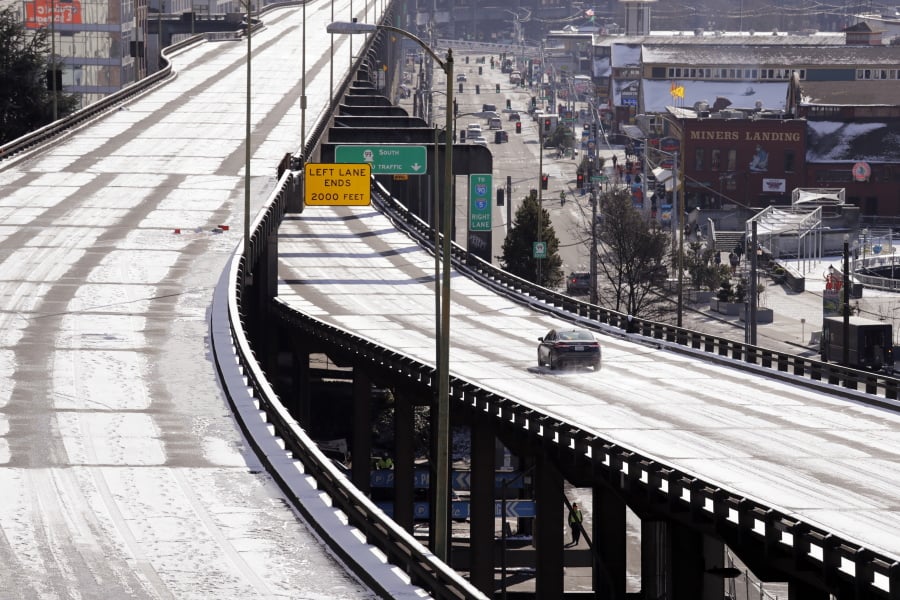A citywide blanket of snow gave the state’s new Highway 99 tunnel the soft launch it needed Monday morning.
Because many motorists stayed home, traffic was far below 97,000 daily trips that are projected to use the two-mile, four-lane tube under downtown Seattle.
In fact, only 22,145 vehicles used the tunnel its first day, the Washington State Department of Transportation said Tuesday afternoon. Second-day traffic at 8 a.m. Tuesday appeared heavier, but still far below normal commute days.
The low volumes created a forgiving environment for last-minute lane changes at the new exits, without causing much crash risk.
Both directions opened to traffic just after midnight Monday, following a festival weekend where 70,000 walkers, 27,000 runners and 12,000 bicyclists filled the new tunnel and the old Alaskan Way Viaduct. The viaduct will be demolished in five to six months beginning next week, and its rubble will fill the defunct Battery Street Tunnel.
Project officials last week were deliberately vague about when to open the entrances, partly to avoid drivers competing to be the first through the tunnel.
Two new southbound left-side exits, as expected, baffled some motorists who approached the interchanges at the Sodo and South Lake Union ends for the first time.
On a 6:25 a.m. tunnel drive Monday, before the tunnel entrance, three cars were seen making last-minute lane changes at the southbound Denny Way/Seattle Center left exit. At the stadium end, at around noon, a black sedan weaved into and then out of the left-side exit marked for I-5, I-90 and ferries, causing trailing cars in the tunnel to go only 30 mph.
Patience urged
WSDOT engineer Mike Swires last week urged travelers to show patience as motorists adapt. Give extra following distance, officials say.
The only first-day glitch occurred to the north, at the Aurora Bridge, which stayed frozen and accumulated snow in the 6 a.m. hour, so drivers treated the six-lane crossing as a four-lane bridge — eventually reducing it to just one lane each way, with slush or ice alongside.
Plows didn’t show up until just before 9 a.m. and quickly cleared more space southbound. Despite this issue, there were no morning crashes or congestion.
The Seattle Department of Transportation says it treated the Aurora Bridge with salt solution four times between noon Sunday and Monday morning, and met its internal goals of clearing lanes within 12 hours of a snow lull, on all major streets.
On Tuesday morning, all Aurora Bridge lanes were cleared and the city prevented the asphalt deck from refreezing, so drivers could go 40 mph with good traction.
Truck operators could even respond to some problem side streets, such as an icy block of North 50th Street going downhill to Aurora Avenue North. A driver who careened into a yard there walked uphill served as a good Samaritan to following commuters by waving them toward a level detour. Yet some continued past her and a makeshift barricade, spinning toward Aurora. SDOT responded within 20 minutes to apply sand.
The final ramp connection, from northbound Highway 99 next to the stadiums, is expected to open in a week to 10 days; signage will call it the First Avenue South/Downtown exit. Until then, anyone who drives north beyond the West Seattle Bridge must continue into the tunnel until the Mercer Street exit.
The speed limit within the tunnel is 45 mph, which at the primary curve northbound beneath Belltown would allow an alert driver five seconds to avoid a stall or crash ahead. (The right shoulder is only 2 feet wide there.)
The tunnel is brighter than the older I-90 tunnel at Mount Baker, or the I-90 Mercer Island lids. A second bank of lights appears at the two portals, to help drivers’ eyes adjust between daylight and the tunnel.
In addition to the tunnel, a new intersection of Harrison Street across Aurora Avenue North opened Monday morning. Next year, Thomas and John streets will be stretched in a grid across Aurora, which is to be regraded and renamed Seventh Avenue North.



